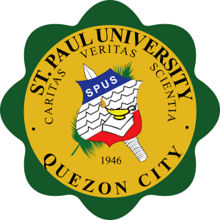St. Paul University Quezon City
 St. Paul University Quezon City seal | |
| Motto | Caritas Christi Urget Nos |
|---|---|
Motto in English | The charity of Christ urges us |
| Type | Private, Roman Catholic |
| Established | 1946 |
| Affiliation | Sisters of St. Paul of Chartres |
| President | Sister Ma. Nilda Masirag, SPC |
| Location | Aurora Boulevard cor. Gilmore Avenue, New Manila, Quezon City, Philippines |
| Colors | Green and Gold |
| Nickname | Paulinians |
| Affiliations | Association of Southeast Asian Catholic Colleges and Universities (ASSEACU), International Federation of Catholic Universities (IFCU), PAASCU |
| Website |
www |
St. Paul University Quezon City (also known as SPUQC) is a private, sectarian and previously a women's college. Situated on a gentle slope of what was originally known as New Manila, the SPUQC campus now occupies an entire block bordered by busy Aurora Boulevard, Gilmore Avenue, Third street, and Dona Magdalena Hemady Street in Quezon City. St. Paul College Quezon City then catered to young women of the upscale area of New Manila
In June 2006, SPUQC started to open its doors to young men who desire to undergo their college education and formation in St. Paul University of Quezon City. The High School department followed suit when the first set of graduates from the co-ed Grade School enrolled in the High School in June 2008. Its sister school St. Paul College Pasig remained an exclusive all-girls school.
St. Paul University of Quezon City is recognized by the Department of Education and the Commission on Higher Education and also a charter member of the Philippine Accrediting Association of Schools, Colleges and Universities. It has earned Level III accreditation on all of its respective departments and schools. On May 2012, PAASCU granted re-accredited status to the Science, Liberal Arts, and Business Programs (except accountancy).
The late actress Ama Quiambao was a former faculty member of AB Mass Communications under the College of Arts, Sciences and Education (CASE) of the university.
History
The college was established as St. Paul College Quezon City Branch in 1946. It was founded by the Sisters of St. Paul of Chartres (SPC), a congregation established in Chartres, France, by Father Louis Chauvet in 1696.
St. Paul College Quezon City then catered to young women of the upscale area of New Manila.
The Liberal Arts and Commerce programs were first granted accreditation status by PAASCU in 1983 along with the High School department. The application for the accreditation of the Science programs followed in 1989. All these programs have periodically been granted re-accreditation status since then.
The grade school was initially offered to boys and girls. Eventually, the high school and college levels were exclusively offered to women, making the school a full women's college in 1966.[1]
Accreditation
The college enjoys full autonomy status from the Commission on Higher Education of the Philippines. It was also awarded a Level III Accreditation (the second highest possible level) by the Philippine Accrediting Association of Schools, Colleges, and Universities (PAASCU).[1]
Academics
The college is also part of the Women's Consortium Colleges which includes Miriam College in Katipunan, Assumption College San Lorenzo in Makati, La Consolacion College Manila in Mendiola, and the College of the Holy Spirit Manila in Mendiola.
Basic Education
- K to 12
Tertiary Education
- College of Arts, Sciences and Education (CASE)
- B.A. Communication
- Religious Education
- Education
- Psychology
- Biology
- Bachelor of Science in Nursing
- College of Business and Technology (CBT)
- Business Administration major in:
- Marketing
- Human Resource
- Management Accounting
- Entrepreneurship
- Accountancy
- Hotel and Restaurant Management
- Tourism
- Information Technology
- Business Administration major in:
- Center for Career Development (2-year Vocational Courses)
- Executive Assistant
- Hotel and Restaurant Service
- Caregiver
- Massage Therapy
Uniform
The St. Paul University system, especially SPUQC, has developed a cult following regarding the school's prescribed uniform. From the checkered skirt to the long sleeved polo (short sleeves for grade school and high school students), cufflinks and neckties exclusively used by Paulinians; and the required simple black shoes with a maximum heel height of 2-3 inches, SPUQC trains their students to be well-balanced, sleek and professional to be the best that they can be in the future.
Notable alumni
- Rhea Santos (Mass Communications Batch 2000) - GMA-7 newscaster
- Jackie Lou Blanco - Actress
- Tootsie Guevara (Hotel and Restaurant Management Batch 2003) - former ABS-CBN actress, singer and recording artist
- Gov. Nini Ynares - Governor Rizal province
- Cong.Trisha Bonoan - David - Congresswoman 4th District Manila
- Tweetie De Leon-Gonzalez - Super Model
- Liezl Sumilang-Martinez - Actress, MTRCB Board
- Maxine Medina (HS Batch 2009) - Miss Universe Philippines 2016
- Alex Gonzaga - Actress, ABS-CBN
- Rafael Velasco - CEO,ABS-CBN
- Annabelle Regalado-Borja (Mass Communications)- CEO Star Records, Talent Manager, Concert Producer/Promoter
References
- 1 2 Official prospectus, St. Paul University Quezon City, 2006.
| Wikimedia Commons has media related to St. Paul University Quezon City. |